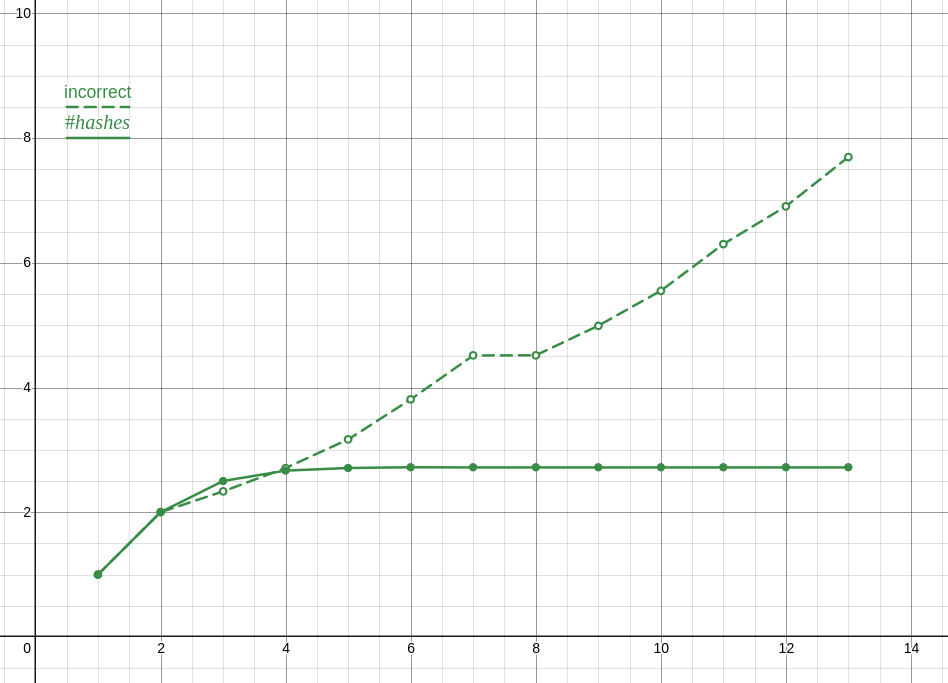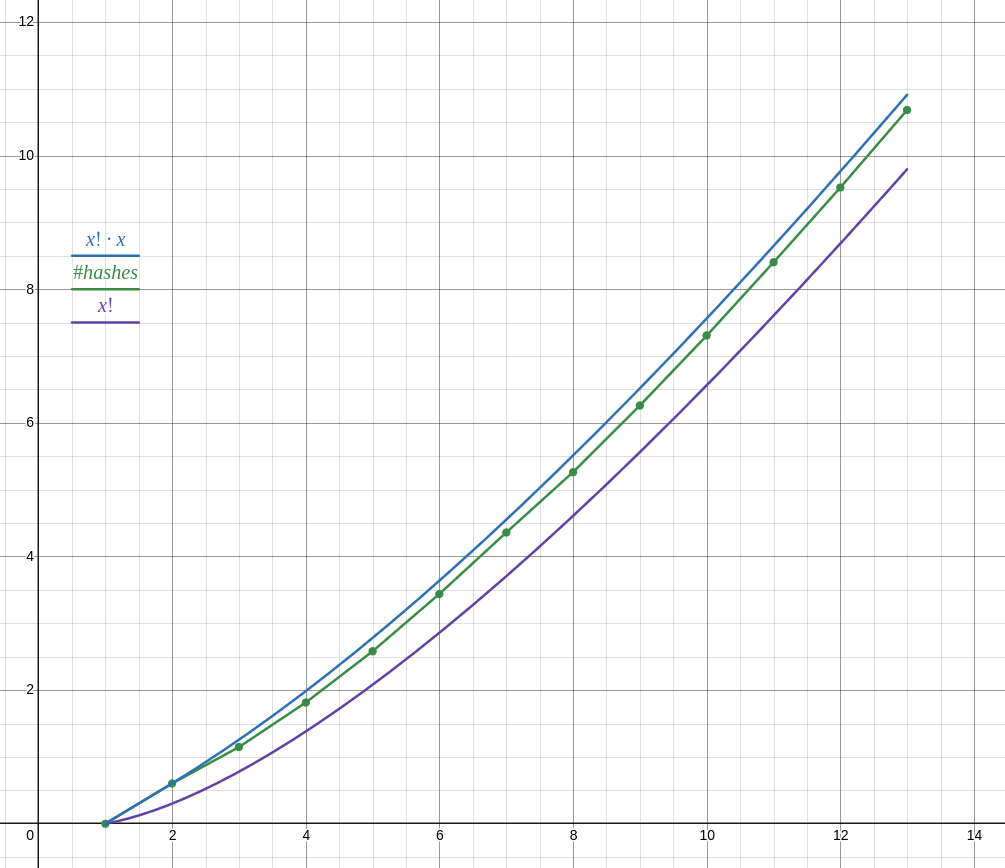

see how strong the propaganda is hmm ? /j
nya !!! :3333 gay uwu
I’m in a bad place rn so if I’m getting into an argument please tell me to disconnect for a bit as I dont deal with shit like that well :3


see how strong the propaganda is hmm ? /j


Agh I made a mistake in my code:
if (recalc || numbers[i] != (hashstate[i] & 0xffffffff)) {
hashstate[i] = hasher.hash(((uint64_t)p << 32) | numbers[i]);
}
Since I decided to pack the hashes and previous number values into a single array and then forgot to actually properly format the values, the hash counts generated by my code were nonsense. Not sure why I did that honestly.
Also, my data analysis was trash, since even with the correct data, which as you noted is in a lineal correlation with n!, my reasoning suggests that its growing faster than it is.
Here is a plot of the incorrect ratios compared to the correct ones, which is the proper analysis and also clearly shows something is wrong.

Anyway, and this is totally unrelated to me losing an internet argument and not coping well with that, I optimized my solution a lot and turns out its actually faster to only preform the check you are doing once or twice and narrow it down from there. The checks I’m doing are for the last two elements and the midpoint (though I tried moving that about with seemingly no effect ???) with the end check going to a branch without a loop. I’m not exactly sure why, despite the hour or two I spent profiling, though my guess is that it has something to do with caching?
Also FYI I compared performance with -O3 and after modifying your implementation to use sdbm and to actually use the previous hash instead of the previous value (plus misc changes, see patch).


you forgot about updating the hashes of items after items which were modified , so while it could be slightly faster than O((n!×n)²) , not by much as my data shows .
in other words , every time you update the first hash you also need to update all the hashes after it , etcetera
so the complexity is O(n×n + n×(n-1)×(n-1)+…+n!×1) , though I dont know how to simplify that


actually all of my effort was wasted since calculating the hamming distance between two lists of n hashes has a complexity of O(n) not O(1) agh
I realized this right after walking away from my devices from this to eat something :(
edit : you can calculate the hamming distance one element at a time just after rehashing that element so nevermind


honestly I was very suspicious that you could get away with only calling the hash function once per permutation , but I couldn’t think how to prove one way or another.
so I implemented it, first in python for prototyping then in c++ for longer runs… well only half of it, ie iterating over permutations and computing the hash, but not doing anything with it. unfortunately my implementation is O(n²) anyway, unsure if there is a way to optimize it, whatever. code
as of writing I have results for lists of n ∈ 1 … 13 (13 took 18 minutes, 12 took about 1 minute, cant be bothered to run it for longer) and the number of hashes does not follow n! as your reasoning suggests, but closer to n! ⋅ n.

anyway with your proposed function it doesn’t seem to be possible to achieve O(n!²) complexity
also dont be so negative about your own creation. you could write an entire paper about this problem imho and have a problem with your name on it. though I would rather not have to title a paper “complexity of the magic lobster party problem” so yeah


unless the problem space includes all possible functions f , function f must itself have a complexity of at least n to use every number from both lists , else we can ignore some elements of either of the lists , therby lowering the complexity below O(n!²)
if the problem space does include all possible functions f , I feel like it will still be faster complexity wise to find what elements the function is dependant on than to assume it depends on every element , therefore either the problem cannot be solved in O(n!²) or it can be solved quicker


this would assume that finding the next prime is a linear operation , which is false


if I’m not mistaken , a example of a problem where O(n!²) is the optimal complexity is :
There are n traveling salespeople and n towns . find the path for each salesperson with each salesperson starting out in a unique town , such that the sum d₁ + 2 d₂ + … + n dₙ is minimised, where n is a positive natural number , dᵢ is the distance traveled by salesperson i and i is any natural number in the range 1 to n inclusive .
pre post edit, I realized you can implement a solution in 2(n!) :(


honestly what makes it even more funny is that she claims to be an anarchocapitalist


congrats on the 666th comment btw
also the way I learned of her was a post on hexbears dunk tank of her hornyposting about lobotomy (receiving) on main


Mozilla has a history of harming me. I’ve documented this as one more case of attacks from Mozilla to go along with everything else. I see no reason to put up with it or tolerate it. Mozilla should expect that one day they’re going to be held accountable. If people at Mozilla aren’t aware of the unethical behavior it regularly engages in including an exploitative approach to contributors, they should inform themselves.
- Daniel Micay (im the linked mailing list thread)
it doesn’t seem like Micay had feuds previous to 2019 with Mozilla , though I was unable to find what he is referring to unfortunately .


also I would recommend this video & and others by shounic

can’t you see ? they also have a website


I consider myself like a right wing capitalist libertarian
Linky with time code (7:4:0) , wrong sub com maybe ?
I misread this as if it lacked the y and was slightly confused for a second


to be fair , neither the free software movement nor the open source movement (which are distinct ideologically) are explicitly socialist . in a way , especially the free software movement , they embody an extention of liberalism .
both of these movements focus on the individuals freedom and take issue not with developers/companies being systemically incentivized to develop closed source / nonfree software , but with individual developers/companies doing so . thus the solution taken is limited to the individual not to systemic change .


what does the octothorpe s mean in the top right ?


to be fair age of consent in Poland is 15
btw her “anarchism” is literally neo-feudalism so yeah